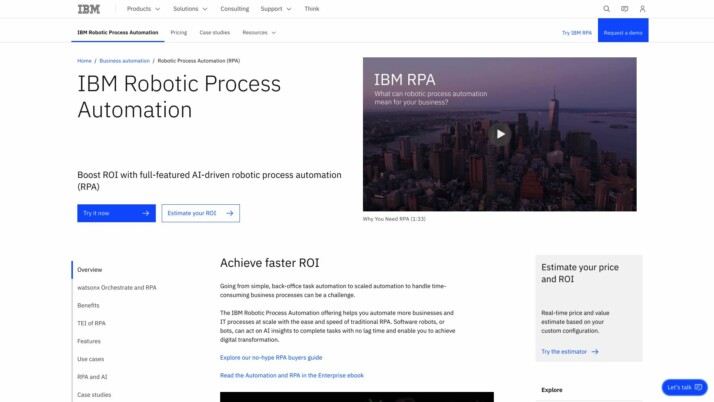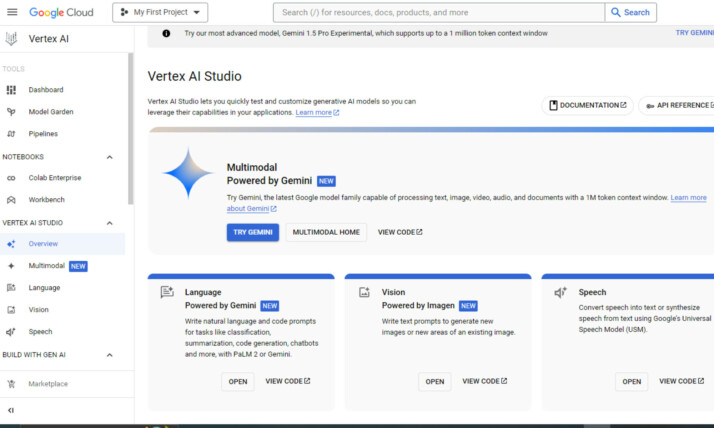IBM RPA vs. Vertex AI: Choosing the Right AI Automation Platform
AI-powered automation platforms transform business operations, offering unprecedented efficiency and innovation. IBM RPA vs. Vertex AI stand out as powerful solutions, each with unique strengths. IBM RPA excels in streamlining repetitive tasks across enterprise systems, while Vertex AI delivers advanced machine learning capabilities. This comparison explores their key features, use cases, and limitations, helping you navigate the complex landscape of AI automation tools.
We’ll also introduce SmythOS, a versatile alternative that combines robust automation with user-friendly design, catering to businesses of all sizes. Whether you’re a developer seeking powerful APIs, a business leader focused on scalability, or an entrepreneur looking for accessible AI solutions, this guide will empower you to make an informed decision for your organization’s AI journey.
IBM RPA Overview
IBM Robotic Process Automation (RPA) empowers organizations to automate repetitive tasks across various applications and systems. This enterprise-grade platform enables users to build, deploy, and manage software bots that mimic human interactions with digital systems.


IBM RPA offers a comprehensive suite of tools for creating and orchestrating automated workflows. Its visual builder simplifies bot creation, allowing both technical and non-technical users to design automation processes through intuitive drag-and-drop interfaces. The platform supports both attended and unattended bots, catering to scenarios that require human intervention and those that can run autonomously.
IBM RPA offers a comprehensive suite of tools for creating and orchestrating automated workflows. Its visual builder simplifies bot creation, allowing… users to design automation processes through intuitive drag-and-drop interfaces.
Key features of IBM RPA include AI-driven automation capabilities, seamless integration with existing enterprise systems, and robust security measures. The platform’s AI integration, powered by watsonx Orchestrate, enables bots to handle complex decision-making tasks and adapt to changing scenarios. This combination of RPA and AI allows for more intelligent and flexible automation solutions.
IBM RPA excels in scalability and enterprise-readiness. It provides dedicated environments for development, testing, and production, ensuring smooth transitions from bot creation to deployment. The platform’s ability to handle high-volume, concurrent bot execution makes it suitable for large-scale automation initiatives. Additionally, its integration with IBM OpenPages for governance and compliance adds a layer of transparency and auditability crucial for regulated industries.
IBM RPA excels in scalability and enterprise-readiness. It provides dedicated environments for development, testing, and production, ensuring smooth transitions from bot creation to deployment.
While IBM RPA offers a powerful set of features, its enterprise focus may present a steeper learning curve for smaller organizations or individual users. The platform’s complexity and extensive capabilities could potentially require significant resources for full implementation and management. However, for large enterprises seeking a robust, AI-enhanced automation solution, IBM RPA provides a comprehensive toolkit to drive efficiency and digital transformation across their operations.
Vertex AI Overview
Vertex AI streamlines machine learning operations for enterprises and developers. This comprehensive platform integrates data engineering, data science, and ML engineering workflows, enabling seamless collaboration through a unified toolset.


Vertex AI’s standout feature is its Multimodal Generative AI Model, Gemini. These advanced models support multimodal prompts, including text, images, audio, video, and PDFs. Gemini excels in reasoning, multiturn chat, code generation, and content creation, making it versatile for various AI applications.
Vertex AI’s standout feature is its Multimodal Generative AI Model, Gemini … support multimodal prompts, including text, images, audio, video, and PDFs.
The platform’s Generative AI Workflow incorporates a Model Garden, allowing users to discover, test, and deploy a variety of AI models. Vertex AI enables model customization, improving cost-efficiency and response times. Features like grounding, RAG, and function calling enhance model responses with real-time information and external API integration.
Vertex AI’s robust AI Model Management includes a centralized Model Registry and Feature Store for efficient ML feature serving. The platform also offers MLOps tools for monitoring model performance and orchestrating workflows. Specialized models like Imagen for text-to-image generation and MedLM for healthcare applications expand its capabilities.
While Vertex AI offers powerful features, its complexity may challenge users without extensive ML expertise. The platform’s enterprise focus might make it less accessible for smaller teams or individual developers. Additionally, as a Google Cloud product, it may require commitment to the Google ecosystem, potentially limiting flexibility for users preferring multi-cloud or hybrid solutions.
Feature Comparison
IBM RPA and Vertex AI offer distinct approaches to AI and automation. IBM RPA excels in robotic process automation, providing tools to automate repetitive tasks across enterprise systems. Its visual builder and low-code authoring capabilities enable quick bot creation for both technical and non-technical users. IBM RPA’s integration with watsonx Orchestrate adds AI-driven decision-making to automation workflows.
Vertex AI, on the other hand, focuses on comprehensive machine learning operations. It offers advanced features like the Multimodal Generative AI Model Gemini, supporting complex AI tasks across text, images, audio, and video. Vertex AI’s Model Garden allows users to discover, test, and deploy various AI models, including Google’s proprietary models and select open-source options.
In terms of core components, IBM RPA provides robust tools for bot development and management, including hosted environments for development and production. However, Vertex AI offers more advanced AI model management features, including a centralized Model Registry and Feature Store for efficient ML feature serving. Vertex AI also provides specialized models like Imagen for text-to-image generation and MedLM for healthcare applications, capabilities not present in IBM RPA.
Regarding security, both platforms offer strong measures. IBM RPA integrates with IBM OpenPages for governance and compliance, while Vertex AI, being a Google Cloud product, leverages Google’s advanced security infrastructure. However, specific details on features like constrained alignment and IP control are more explicitly mentioned for IBM RPA than for Vertex AI in the available information.
While both platforms offer powerful capabilities, they serve different primary purposes — IBM RPA for process automation and Vertex AI for advanced machine learning operations. The choice between them would depend on specific organizational needs and existing technology ecosystems.
Feature Comparison Table
| IBM RPA | Vertex AI | SmythOS | |
|---|---|---|---|
| CORE FEATURES | |||
| AI Agents | ❌ | ✅ | ✅ |
| No-Code Options | ✅ | ❌ | ✅ |
| Memory & Context | ❌ | ✅ | ✅ |
| Autonomous Agents | ❌ | ✅ | ✅ |
| Explainability & Transparency | ❌ | ✅ | ✅ |
| Multimodal | ❌ | ✅ | ✅ |
| Problem-Solving Capabilities | ❌ | ✅ | ✅ |
| Multi-Agent Collaboration | ❌ | ✅ | ✅ |
| Audit Logs for Analytics | ✅ | ❌ | ✅ |
| Work as Team | ❌ | ✅ | ✅ |
| SECURITY | |||
| Constrained Alignment | ❌ | ✅ | ✅ |
| OAuth | ❌ | ✅ | ✅ |
| IP Control | ❌ | ✅ | ✅ |
| COMPONENTS | |||
| Foundation AIs | ❌ | ✅ | ✅ |
| Huggingface AIs | ❌ | ❌ | ✅ |
| Zapier APIs | ❌ | ❌ | ✅ |
| Classifiers | ❌ | ✅ | ✅ |
| Data Lakes | ❌ | ✅ | ✅ |
| DEPLOYMENT OPTIONS (EMBODIMENTS) | |||
| Deploy as Webhook | ❌ | ✅ | ✅ |
| Staging Domains | ❌ | ✅ | ✅ |
| Production Domains | ❌ | ✅ | ✅ |
| API Authentication (OAuth + Key) | ❌ | ✅ | ✅ |
| Deploy as Site Chat | ❌ | ✅ | ✅ |
| Deploy as GPT | ❌ | ✅ | ✅ |
| DATA LAKE SUPPORT | |||
| Hosted Vector Database | ❌ | ✅ | ✅ |
| Sitemap Crawler | ❌ | ❌ | ✅ |
| YouTube Transcript Crawler | ❌ | ❌ | ✅ |
| URL Crawler | ❌ | ✅ | ✅ |
Best Alternative to IBM RPA and Vertex AI
SmythOS stands out as the superior alternative to IBM RPA and Vertex AI, offering a comprehensive AI automation platform that combines ease of use with powerful features. Our platform empowers users to create and deploy AI agents quickly and efficiently, addressing a wide range of use cases that surpass the capabilities of traditional RPA and ML platforms.
Unlike IBM RPA’s focus on robotic process automation or Vertex AI’s emphasis on machine learning operations, SmythOS provides a versatile ecosystem for building intelligent agents. We offer a user-friendly drag-and-drop interface that simplifies the creation of complex AI workflows, making advanced AI functionalities accessible to both technical and non-technical users.
SmythOS excels in areas where IBM RPA and Vertex AI fall short … our platform bridges this gap with a no-code approach that doesn’t compromise on sophistication.
SmythOS excels in areas where IBM RPA and Vertex AI fall short. While IBM RPA lacks true AI agent capabilities and Vertex AI may require extensive coding knowledge, our platform bridges this gap with a no-code approach that doesn’t compromise on sophistication. We support multimodal interactions, autonomous agent behavior, and seamless multi-agent collaboration — features that are either limited or absent in the competing platforms.
Our platform’s extensive integration ecosystem sets us apart from both IBM RPA and Vertex AI. SmythOS offers pre-built API integrations and templates for common tasks, significantly reducing setup time and allowing users to focus on innovation. This flexibility ensures that our platform can adapt to virtually any workflow or business process, a crucial advantage over more rigid systems.
In terms of deployment options, SmythOS offers unparalleled versatility. Our agents can be deployed across various platforms, including as APIs, webhooks, site chats, and even as ChatGPT plugins or Alexa skills. This level of deployment flexibility, combined with our robust security features and scalability, makes SmythOS the ideal choice for businesses looking to harness the full potential of AI across their operations.
Conclusion
IBM RPA and Vertex AI offer powerful solutions for enterprise automation and machine learning, respectively. IBM RPA excels in robotic process automation, providing tools to streamline repetitive tasks across business systems. Its visual builder and AI-driven decision-making capabilities make it a strong choice for organizations seeking to enhance operational efficiency. Vertex AI, on the other hand, shines in the realm of advanced machine learning operations, offering state-of-the-art features like the Gemini multimodal AI model and specialized tools for healthcare and image generation.
However, SmythOS emerges as the superior choice, combining the strengths of both platforms while offering unparalleled versatility and ease of use. Our drag-and-drop interface democratizes AI development, allowing users to create complex workflows without extensive coding knowledge. With support for over 300,000 integrations and compatibility with various AI models, SmythOS adapts to virtually any business process or industry need.
Unlike IBM RPA and Vertex AI, which may present steep learning curves or ecosystem lock-in, SmythOS prioritizes accessibility and flexibility. Our ’Create Once, Deploy Anywhere’ approach enables seamless integration across multiple platforms, from chatbots to APIs, ensuring your AI solutions work where you need them most. This versatility, combined with our robust security features and scalable architecture, makes SmythOS ideal for businesses of all sizes seeking to harness the full potential of AI.
Experience the future of AI automation with SmythOS. Explore our diverse range of AI-powered agent templates to jumpstart your journey, or create a free account to build and deploy unlimited AI agents with no time limit. Discover how SmythOS can transform your workflow and drive innovation in your organization today.
Last updated:
Disclaimer: The information presented in this article is for general informational purposes only and is provided as is. While we strive to keep the content up-to-date and accurate, we make no representations or warranties of any kind, express or implied, about the completeness, accuracy, reliability, suitability, or availability of the information contained in this article.
Any reliance you place on such information is strictly at your own risk. We reserve the right to make additions, deletions, or modifications to the contents of this article at any time without prior notice.
In no event will we be liable for any loss or damage including without limitation, indirect or consequential loss or damage, or any loss or damage whatsoever arising from loss of data, profits, or any other loss not specified herein arising out of, or in connection with, the use of this article.
Despite our best efforts, this article may contain oversights, errors, or omissions. If you notice any inaccuracies or have concerns about the content, please report them through our content feedback form. Your input helps us maintain the quality and reliability of our information.

